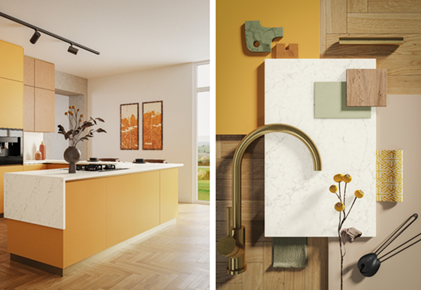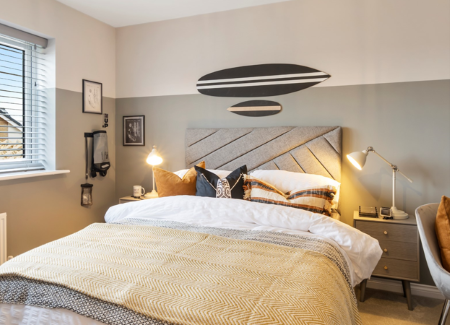Showhome spoke to The Tile Association, who explained the technical aspects of combining first class tiling jobs with increasingly popular underfloor heating systems in new build properties.
The Tile Association has been running technical seminars for tiling professionals on precisely this subject for several years, and has a programme of new seminars coming up this spring.
The housing sector is regaining some of its former buoyancy – much to the relief of everyone in the industry. New private home registrations were up 9% during 2014 to 145,174. As the year went on, the pubic sector seemed to be benefitting as well, with Q3 seeing the largest quarterly growth since 1997.
Meanwhile, running in parallel with growth in the overall market, there has been a huge surge in interest in underfloor heating systems (UFH) over the past five years, as knowledge of the benefits and ease with which UFH can be installed has evolved. Industry estimates indicate that the market has been virtually doubling annually in recent years. It is easy to see why, as UFH provides cost-effective, comfortable, unobtrusive heating in millions of properties throughout Europe and is now established as a mainstream heating choice in the UK as well.
Its use enables building designers to meet modern energy efficiency regulations, reduce the carbon footprint of buildings and allow for the implementation of contemporary design concepts. Research amongst homebuyers is also now indicating that a significant proportion are looking at underfloor heating as a point of difference and a good USP on the resale market. So there is definitely an attraction for house builders who want to enable their customers to maximize the saleability and value of their properties. The use of UFH with tiling transforms what is traditionally viewed as a rigid and cold surface, into a warm and welcoming environment.
UFH installations are increasingly tied to renewable energy sources, because of the lower running temperatures of the technology, and this concept appeals to consumers who aspire to a zero carbon house, as well as those who just want to reduce their fuel bills. It therefore seems certain that the UFH will continue to grow rapidly in importance.
For homeowners, the latest innovations mean high comfort levels, consistent temperatures and greater cleanliness, coupled with low running costs, because the systems tend to employ large surface areas heated to a lower temperature. The installation cost of UFH in new build is comparable to a standard radiator system but it can provide 30% greater energy efficiency compared to traditional space heating.
So these systems have become a mainstay of modern house construction, and there are two different types to consider. The first category comprises electric matting systems, installed directly under a tiled floor and which are therefore laid as part of the tiling process. The second group is made up of warm water (wet) systems, which are installed within a screed. Installing electric UFH is less disruptive than a warm water system and more suitable for small scale – less than 20sq m – installations, like bathrooms. However, an electric system tends to be more expensive to run when compared with warm water UFH – as a general rule 30-40% more.
Warm water is ideal for installation in new build, complete renovations, extensions and large areas in general. It can be linked in to an existing radiator system and most effective when installed with alternative energy sources such as geothermal or solar.
The installation of such systems, particularly wet systems, is not however always problem-free. Historically, cracked tiles were associated with heated floor construction. Inappropriate tiles or adhesives used on equally inappropriate substrates would result in weakness or fragility. Surface deformation, resulting in tenting and debonding, or cracks in the tiled surface covering, can be caused by the different rates at which different materials expand when heated.
Also, if expansion joints are poorly positioned, problems will arise when the different elements of the floor assembly move at different rates. Of course quality of workmanship can also be an issue.
The TTA compiles and issues guidance for the trade on how to avoid the pitfalls associated with underfloor heating installations, and at its Staffordshire head office it has a considerable resource of technical information to help installers. The Association also runs periodic technical seminars, with a new programme starting in May, the first one of which is on the subject of underfloor heating.
There are a number of areas that installers need to look out for in order to avoid problems. Firstly, warm water underfloor heating systems should be installed according to British Standards.
Since ceramics and natural stone are rigid finishes that will not deform laterally when they are bonded directly to the heated screed with adhesives – intermediate movement joints are essential. This requirement applies for all types of rigid screeds including cementitious and calcium sulfate based screeds.
The provision and detailing of intermediate joints should be considered at the design stage and the thermal movements of the substrate assembly should be taken into account.
Insulation should be laid beneath the UFH system to ensure that the heat always rises upwards and is not absorbed into the sub-floor. Movement joints should also be installed to all perimeters of the floor.
The floor screed should be applied in accordance with British and European Standards. Cement sand screed should be steel mesh reinforced.
On completion of the floor heating system, all necessary tests must be carried out including a hydraulic pressure test for wet systems, and cable resistance and continuity plus earth tests for electrical systems.
Screeding should take place as soon as possible after an underfloor installation is laid and pressure-tested. Care must be taken to protect the pipework whilst working. The mixture must be well compacted around the pipes to make certain that there are no voids or hollows. The water pressure should be maintained at operating pressure during the screeding process.
The floor should be allowed to cure and dry naturally until full strength is reached as per the British Standards and manufacturer instructions. The full drying time of the floor will depend on the depth and products used. Good ventilation or the use of dehumidifiers can assist in reducing the atmospheric humidity.
Once the screed has cured and dried, the underfloor heating should be brought into operation, increasing temperature gradually over a few days, then examined for any signs of fracturing. The screed should then be allowed to cool before tiling installation commences.
Tiling installers, building designers and other construction professionals who are keen to find out more are encouraged to attend the TTA’s forthcoming technical seminars, to be held from May this year in partnership with the CITB.
The first one takes place on Wednesday 6th May, with a morning seminar on ‘Tiling to Heated Floors’ and, following lunch, another seminar on ‘Tiling to Calcium Sulfate Screeds’.
The seminars – which are based on the TTA’s highly respected technical documents in these areas – will be delivered by Brian Newell, TTA board member and Technical Committee Chairman, and Colin Stanyard, Mapei’s technical manager and TTA technical committee member.
Places are strictly limited to 30 for each event and operate by advance booking. There’s a small charge for the day covering administration, lunch and handouts – at £35 per person for members and £45 for non-members. Places can be booked now for the first event on 6th May by calling the TTA on 0300 3658453 or emailing support@tile.org.uk






